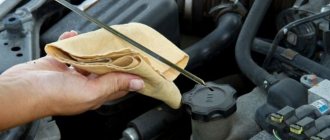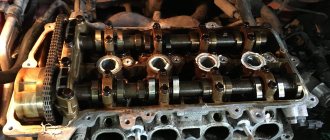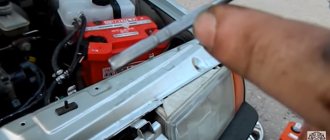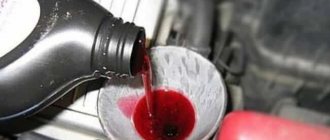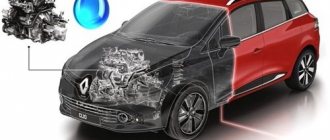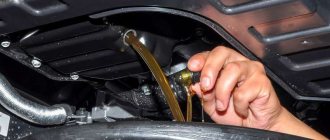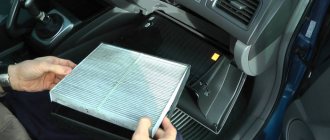The benefits of using molybdenum with its unique properties for lubricating working units were appreciated back during the Second World War, when additives were actively used in tanks and helicopters.
The reason for such popularity is that this chemical compound is capable of enveloping all mechanisms without losing its properties at either positive or negative critical temperatures, and also protects iron from stopping the units. But it also has negative properties that few people know about.
What is molybdenum
Molybdenum (Mo) , chemical element No. 42 on the periodic table, is a light gray metal. Widely used in electrical and automotive industries. Molybdenum is not found in its pure form; the raw material for its production is ore. The most commonly mined mineral is molybdenite , which is relatively rare and not cheap.
Molybdenum is widely used due to its anti-friction properties , i.e. ability to reduce the coefficient of friction of other substances.
It also has other valuable properties:
- infusibility;
- heat resistance;
- strength;
- good electrical conductivity;
- anti-corrosion.
Due to its tendency to oxidize quickly (it begins to oxidize already at 400 C), the metal is practically not used in its pure form.
Advantages of the additive
Currently, inorganic substances based on molybdenum are almost never used in high-quality motor oils; they have been replaced by organics.
Substances designated as MoDTC or MoDTP ; these are more effective friction modifiers that, under certain conditions, can even alloy rubbing metal surfaces with molybdenum atoms.
In addition to the already known anti-friction properties, the effect of hardening the surfaces is added, between which a strong and slippery additional layer of solid lubricant remains. These substances are more stable and impart new properties to motor oils.
This is especially important for low-viscosity seasonal and energy-saving oils used at low temperatures, the film of which does not have high base strength. Although these compounds are often added to more traditional products, they are in smaller quantities.
The stability of the boundary layer is ensured by its dynamic updating. The additive molecules are constantly contained in the oil and the protection is renewed as its molecules are consumed in the friction zone.
Therefore, you should not believe statements that call for treating the engine once, creating protection that works even after changing the oil to regular oil. The timing of the renewal of the lubricating product should not be violated, no matter what properties it has.
Liqui Moly Company
Motor oils produced by the German company Liqui Moly are popular in many countries around the world. The products have won the love of many motorists with their quality, wide range, as well as the authority of the company itself.
Liqui Moly holds a leading position in the lubricants and auto chemicals market.
Products are manufactured only in Germany. This allows you to monitor all processes and the quality of the manufactured goods.
The company is distinguished by a large number of innovative components, as well as a careful attitude towards the environment. These features are reflected in the products.
About the manufacturer Mannol
The German company began its work in 1996. The first batch of lubricants was immediately distributed throughout Europe and received positive feedback from users and experts. From the first year of existence to this day, the manufacturer has been proving the high quality of its products. Today the company's product range includes a wide selection of lubricants for gasoline, diesel or gas engines used in any conditions. The main indicator of the quality of oils is our own laboratory, where the product is created, tested and verified.
On the shelves you can find mineral, synthetic and semi-synthetic oils used for cars, trucks and commercial vehicles. The main difference from competitors is StahlSynt’s own production technology, which reduces wear of metal elements; the constant use of Mannol oil reduces engine wear by almost 40%.
There are original lines designed for specific car brands - Opel, Chevrolet, Hyundai, Kia, Peugeot, Citroen. Initially intended only for cars for service, but later went on sale. When creating the oil, the difficult climates of some regions of Russia, different driving styles, and the use of low-quality fuel are taken into account. The line is created using a package of chemical additives, the composition of which is kept secret by the manufacturer.
The company's oils contain molybdenum disulfide, which helps smooth out roughness that forms on the surface of internal engine parts as a result of its production. That is, regular use of Mannol oil helps restore even old engines, make them run smoother, and reduce fuel consumption. The additive package contains detergent elements that remove dirt from the engine.
This is undoubtedly an excellent example of a lubricant, and the price of the product is relatively low. The only drawback is the presence of a large number of fakes on the market. It is the purchase of counterfeit goods that creates most of the negative reviews about the manufacturer.
Purpose
Liqui Moly Molygen New Generation 5W-40 is designed for modern gasoline and diesel engines - naturally aspirated and turbocharged, with catalytic converters and particulate filters. Compatibility with engines powered by environmentally friendly fuels, such as bioethanol or natural gas, is also claimed. The oil is suitable for cars of foreign and domestic brands, taking into account the availability of appropriate approvals. Among them, we note not only Volkswagen, but also the premium brands BMW, Mercedes-Benz and Porsche.
The original product Liqui Moly Molygen New Generation 5W-40 has great potential for everyday use within the city with frequent starts and braking in traffic jams, as well as at maximum speed on country highways. Moreover, the oil is resistant to extreme temperature changes, as well as heavy loads (for example, transporting goods). Based on this, oil from Liqui Moly can be recommended to owners of commercial vehicles.
The 5W-40 marking characterizes the oil as an all-season lubricant with universal viscosity characteristics. This can be seen judging by the marking W (Winter), as well as the number 5, which indicate compatibility with sub-zero temperatures down to minus 35 degrees Celsius. In addition, let's pay attention to the number 40, which allows you to use the oil at positive temperatures up to 40 degrees. Therefore, oil labeled 5W-40 is suitable for a wide range of common summer and winter temperatures.
Test results
The oil performed well in the power test, which can be found here https://www.autodela.ru/main/top/test/Liqui-Moly-Molygen-NG_test. The oil also performed well in user lab tests. The only indicator in which the oil is suggestive is the viscosity of the simulated cold cranking CCS at -30 degrees - 6166. A high indicator that does not provide a reserve after -30. But it can also be considered as a plus - the viscosity will be stable even after a significant mileage.
Advantages
- High cleaning properties.
- Unusual green color of oil as an indicator of lubricant leakage.
- Can be used for extended intervals.
- Stable viscosity throughout the entire period of use.
- Stable under high loads.
- It is a complete analogue of service oil from LIQUI MOLY, sold only at service stations.
Flaws
- High viscosity at -30 degrees, which can make cranking difficult in cold weather.
Specifications
| Index | Test method (ASTM) | Meaning | Unit | |
| 1 | Viscosity characteristics | |||
| – | Viscosity grade | SAE J300 | 5W-40 | |
| – | Density at +15 °C | DIN 51757 | 0.855 | g/cm³ |
| – | Viscosity at +40°C | ASTM D 7042-04 | 80.7 | mm²/sec |
| – | Viscosity at +100°C | ASTM D 7042-04 | 14.0 | mm²/sec |
| – | HTHS at 150°C | ASTM D 5481 | >= 3.5 | mPas |
| – | Volatility(Noack) | DIN 51581 | 11 | % |
| – | Viscosity index | DIN ISO 2909 | 180 | |
| – | Base number | DIN ISO 3771 | 11.3 | mg KOH/g |
| – | Sulfated ash | DIN 51575 | 1,0-1,6 | g/100g |
| – | Color | green, fluorescent | ||
| 2 | Temperature characteristics | |||
| – | Flash point | DIN ISO 2592 | 230 | °C |
| – | Pour point | DIN ISO 3016 | -45 | °C |
Verdict
A good oil with stable viscosity, high engine power, reduced consumption and high detergent properties. A little unstable after -30, but for 5W-40 this figure is within the standard. It has its own distinctive features, some of which are even unusual, like the color of the oil itself.
When compared with its closest competitors in the segment, the oil has a pour point 3 degrees lower than MOBIL 1 FS X1 5W-40 and ELF Evolution 900 SXR 5W-40. The washing properties are inferior to MOBIL 1, which shows 12.68, against 11.3 for LIQUI MOLY, but it wins over ELF with its alkali indicator of 10.1.
Specifications
Lubricants of different brands of Liqui Moly of the same viscosity class corresponding to SAE 5W40 have different properties, this is due to the introduction of additives. The main operating parameters of lubricants are similar. The limits of rotation at sub-zero critical temperatures are not lower than 6.6 thousand MPa-s. With positive income – up to 60 thousand. Kinematic viscosity at 100°C is not lower than 14.1 mm2/s, the lower limit for oils of this class is 12.5. Liqui Moly liquids have a good safety margin and can work under stressful operating conditions. Viscosity index in the range of 169–180. Freezing temperature -42–45°C.
Classification
- SAE is an American international standard (US Association of Automotive Engineers), which is represented by the following classes:
- Winter - indicated as W (Winter) and six viscosity levels - from 0W to 25W
- Summer - marked with a viscosity number. There are five levels in total - from 20 to 60
- All-season - contains Russian GOST or international double marking in the form of SAE 15W-30.
- API is another American standard from the US Petroleum Institute, which is classified into two categories:
- Service – for gasoline 4-stroke engines of passenger and commercial cars. This category includes ten classes with Latin designations. The higher the oil requirement, the closer the letter is to the end of the alphabet. Thus, the most technologically advanced oil in this case is SL class fluid for gasoline multi-valve turbocharged internal combustion engines.
- Commercial – for trucks, agricultural and road construction vehicles with diesel engines. This category includes eleven classes with the same designation method (Latin letters) as the Service category. In this case, the most advanced class is CI-4 class fluid for high-speed diesel units.
Universal oils according to API are designated by a double symbol separated by a fraction - for example, SG/CD. Only a valid certificate, and not a mark of the same name on the product label, allows you to verify the actual compliance of an oil with the API class.
- ILSAC is an international Japanese-American standard developed specifically for Japan and the USA. Includes five classes, the first of which is obsolete and irrelevant. The remaining GF classes are presented below.
- GF-2 - has been in effect since 1996, complies with the API SJ classification and is compatible with viscosity classes 0W-20 and 5w-20. In addition, it absorbed the viscosity classes from the outdated GF-1 - these are SAE 10W-XX, as well as 0W-XX and 5W-XX, where instead of XX there should be a value from 30 to 60.
- GF-3. Operating since 2001, complies with API SL class. Compared to GF-2 and API, SJ has better antioxidant and anti-wear characteristics. Less susceptible to evaporation and has similar parameters to the IlSAC CF-3 and API SL classes. At the same time, the GF-3 is also equipped with energy-saving technologies.
- GF-4. In operation since 2004, complies with API SM class and is endowed with energy-saving properties. Compared to GF-3, it is resistant to oxidation and has improved cleaning properties. Less prone to deposit formation and also compatible with viscosity grades 0W-20, 5W-20, 0W-30, 5W-30 and 10W-30. We also note compatibility with catalytic converters of harmful exhaust gases (installed in gasoline engines).
- GF-5. In force since 2010, it is compatible with the API SM classification and has more stringent requirements for fuel economy and environmental friendliness. Claimed to be compatible with catalytic converters and elastomers. Also relevant for GF-5 is lower volatility, better cleaning properties and resistance to deposit formation, including in modern turbocharging systems.
Tribological compositions
As manufacturers of tribological compounds state, their products are not additives, but their action is based on creating a “friction-lubrication” pair. The basis of the compositions is similar to molybdenum additives: a lubricating molecular layer is created that prevents wear of the working components of the engine. This composition is used as an additive to oil lubricants.
What happens when a layer is formed:
- first, the abrasives contained in this tribotechnical composition clean the surface;
- then a protective layer is formed, after which the structure of several similar ones is carried out, containing iron molecules;
- the thickness, porosity and other physical properties of the protective layers are adjusted, which adds hydrodynamics and oil-retaining properties to the engine.
Experts believe that such compositions are well suited for various internal combustion engines, make it possible to operate the engine in many extreme situations, including during periods of oil starvation, and also increase engine power by up to 10%.
Only the use of tribotechnical compounds can seriously harm the engine at the component level, provided that the specified provisions in the instructions supplied with the additive are not observed. The manufacturer claims that due to oil-retaining properties, fuel consumption is reduced. The only caveat: such compositions are ideal for engines of new cars or for carefully used engines, otherwise overhaul may not be distant, but closer.
Motor oil performance test
Considering all of the above, we can highlight the key features of the ILSAC class:
- Improved energy-saving characteristics
- Advanced complex of detergent additives for more effective protection against wear products
- Increased compatibility with systems designed to reduce the toxicity of exhaust gases.
- ACEA is an international European standard, which is not inferior in popularity to American and Japanese classifications. Includes the following categories:
- Category A/B – suitable for cars with gasoline and diesel engines (passenger cars and commercial vehicles). This category includes several designations:
- A1/B1 – this designation marks oils with energy-saving properties and low high-temperature viscosity. These oils are recommended for gasoline and diesel internal combustion engines of passenger and commercial vehicles.
- A3/B3 - recommended for more technologically advanced gasoline and diesel engines installed in passenger cars or LCVs. Oil with this marking is characterized by an extended service interval and the ability to withstand heavy loads. In addition, we note its low-viscosity characteristics and reliability for year-round use.
- A3/B4 – marking for motor oils intended for diesel and gasoline engines with direct fuel injection. Such motors are installed on cars or compact trucks. Such oils meet stringent requirements for piston cleanliness.
- A5/B5 - recommended for gasoline and diesel engines designed for motor oils with low-viscosity and energy-saving properties, as well as low high-temperature viscosity and long service intervals.
- Category C - suitable for cars (passenger cars and commercial vehicles) equipped with gasoline or diesel engines with improved environmental characteristics
- Category E – only for diesel trucks with increased payload.
Next, let us pay attention to the suitable specifications and tolerances for Liqui Moly Molygen New Generation 5W-40 synthetic oil:
- API CF/SN;
- ACEA: A3/B4;
- BMW Longlife 01;
- MB 229.5;
- Porsche A40;
- Renault RN 0700;
- Volkswagen 502 00/505 00.
Advantages and disadvantages
No fundamental shortcomings have been identified with Liqui Moly Moligen 5w-40, but the advantages can be listed for a very long time. This oil is good because:
- quickly pumped through the oil system even at low temperatures;
- ensures ease of engine running;
- significantly reduces friction and wear in the engine compartment;
- exhibits stable properties over a wide temperature range;
- has high thermal-oxidative resistance;
- reliably protects the engine from wear;
- exhibits excellent cleaning properties;
- approved for mixing with any fuels and lubricants of similar quality level;
- compatible with catalysts and blower pipes;
- provides fuel economy;
- does not pollute the atmosphere.
Advantages of the additive
Requirements for exhaust emissions and fuel consumption are becoming increasingly stringent. They refer to manufacturers of both motor oils and cars. To restore antifriction layers in areas with a damaged lubricant film, molybdenum disulfide is used, which has the following properties:
- minimizes the amount of scuffing in the engine;
- improves engine lubrication;
- reduces wear.
Engine cylinder scuffing
Similar additives are found in many lubricants produced today. Organic molybdenum interacts well with sulfur. This gives it the opportunity to securely attach to the piston or other moving part that requires high-quality lubrication.
It is known that molybdenum-based oil additives reduce friction of contacting parts. Thanks to this, engine wear is significantly reduced. The engine needs to be repaired much less frequently.
Advantages:
- Effective oil pumpability at the time of start-up, as well as during long-hour trips. Oil constantly flows to the parts, preventing them from dry friction, overheating and premature wear
- Low level of engine noise and vibration
- A high level of detergent, solubilizing and dispersing characteristics helps to effectively clean the engine from contaminants
- Dissipates heat and cools hot components such as pistons and piston rings
- Neutralization of acids, as well as protection against the formation of soot, chlorine, sulfur and other dangerous chemical elements
- No harm to metal parts thanks to anti-corrosion protection
- Compatibility with sealing materials of engines from different cars, as well as neutralization of toxic substances in exhaust gases
- No foaming in cold or hot conditions
- Low carbon dioxide and low volatility.
How to distinguish a fake?
- plastic canisters of uniform color, without paint streaks;
- the stopper is always black, the locking ring remains on the neck when unscrewed;
- the label is made with high quality, any font, even small ones, is easily distinguishable;
- The production date and batch number are printed with indelible ink, the font is even and clear.
Don’t forget about the main method: checking documents with the seller. Any bona fide supplier can present invoices. In addition, the branded oil is not sold on market stalls or roadsides.
How to spot a fake - video recommendations
Reviews
- Valery, Irkutsk region. The oil is of excellent quality, just what the doctor ordered, as they say. In my case, it was “prescribed” by the official dealer. I have a 2012 Ford Focus. I don’t change the oil often, since the engine is not old yet - it is always clean from change to oil change, since I only follow the regulations for 7 thousand km. Previously, I also filled Gazprom Neft with synthetics, it suited me in principle, but I wanted more cleanliness - so as not to worry at all about the reliability of the engine. I got the result - the engine became not only cleaner, but also quieter, and the power also increased. Increased traction when driving uphill. I don’t add oil at all - with such and such regulations. I prefer a five-liter canister - it’s much more economical. In addition, Liqui Molly 5W-40 oil is one of the most expensive. The engine does not overheat at all, both at low and high speeds, all temperatures are normal. In cold weather, the engine starts at minus 30 degrees, and the oil has a normal consistency.
- Nail, Ufa. I have been using Liqui Molly 5W-40 oil since 2006, pouring it into the previous generation Mitsubishi Lancer Evolution. The engine is quite old, but it stays in good spirits - of course, this is not only thanks to high-quality lubrication, but also to timely maintenance of the internal combustion engine. With a range of 180 thousand km, the powerful engine of the Lancer Evo is as torquey and combative as in 2006. The oil becomes dark already in the first thousand km, but this is not a drawback, but rather, on the contrary, indicates the effective cleaning properties of the oil. In addition, darkened grease does not smell burnt. I change the oil every 6 thousand km, since the engine is very old and requires regular maintenance. And this is probably due to the intense driving style - I still love to drive at traffic lights, I really love my car and this oil.
- Igor, Novosibirsk region. Liqui Molly 5W-40 oil has excellent detergent additives, thanks to which you can fully unleash the potential of the engine without worrying about the hydraulic compensators - they never knock and are always in good condition. The waste is minimal, the volatility is low, you have to top up about 100-200 g with a service interval every 10 thousand km. In general, I used to have a VAZ 2109, then there were no problems with the choice of oil at all - I simply filled it with anything, since the Soviet engine handled any kind of nonsense. But when I switched to a Hyundai Solaris, it turned out that there can be difficulties even with a budget foreign car - I mean the choice of oil. In the end, I settled on Liqui Molly, since then the car has driven 100 thousand km. With Liqui Moly oil, hydraulic compensators do not creak at either low or high temperatures. I was pleased with the anti-corrosion protection - no corrosion spots were visible even after 100 thousand km. With this oil, the engine looks like it’s new, so I have an incentive to continue driving the Solaris, and it’s still too early to sell it.
- Nikolay, Lipetsk region. I read a lot about Liqui Molly Molligen 5W-40 oil - reviews, testimonials, tests, etc. I didn’t find anything particularly interesting, but I was just once again convinced that the official dealer really didn’t lie to me - Liqui Molly is ideal for my Daewoo Gentra. The car is relatively new - produced in 2021, with a 1.6 engine and automatic transmission. I've been using this oil since 2017. Naturally, I am wary of fakes. According to the technical parameters, Liqui Molly is suitable for my internal combustion engine. I deal only with official suppliers and large stores. After all, this oil has its own support line and there are certified sellers. Whether I pay more or less does not matter, the main thing is not to hear any extraneous noises and sounds from the engine, and also to be confident in its reliability. The service interval is 12 thousand km. Start at minus 20 degrees. It works on the first try, then you have to turn the starter longer, but this is quite natural (after all, not only everything depends on one oil). At plus 35 degrees, the oil becomes very fluid, which is why leaks occurred. Then I went for diagnostics, during which microcracks were identified in the engine (car mileage was 98 thousand km, this was in April 2021). In addition, the budget seals are still worn out - these Koreans just want to sell them, as they say. The problem was fixed and after that there were no leaks. The engine does not overheat, does not consume more oil than required, and fuel consumption is not excessive (about 10 liters in the city).
Results
Based on the above, we can conclude that the use of molybdenum oil is very risky, both for experienced car owners and for beginners. You should not rely on reviews from other car enthusiasts, since the quality of engines of different cars differs.
Products have their positive and negative qualities, you can take a risk and get results, or you can use a proven type of oil. It is best to use oil with molybdenum additives if it is recommended by the engine manufacturers themselves, and not by advertising companies, this will allow you to let go of all fears and confidently use your car without worrying about the consequences.

